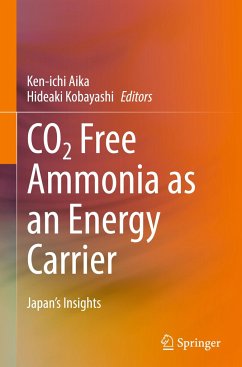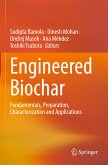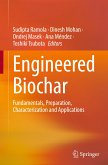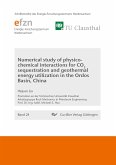CO2 Free Ammonia as an Energy Carrier
Japan's Insights
Herausgegeben:Aika, Ken-ichi; Kobayashi, Hideaki
CO2 Free Ammonia as an Energy Carrier
Japan's Insights
Herausgegeben:Aika, Ken-ichi; Kobayashi, Hideaki
- Gebundenes Buch
- Merkliste
- Auf die Merkliste
- Bewerten Bewerten
- Teilen
- Produkt teilen
- Produkterinnerung
- Produkterinnerung
This book describes important findings in intensive studies conducted in Japan on ammonia as an energy carrier. It illustrates an advanced solar-heat capture system and storage materials at 600°C and hydrogen production with SOECs and a new IS method through the use of heat. New industrial ammonia catalysts and a demonstration process that started running in Fukushima are also introduced. Advanced ammonia decomposition catalysts and the process that were developed for use by the hydrogen station are presented. An advanced direct ammonia fuel cell was developed and the base data are shown. The…mehr
Andere Kunden interessierten sich auch für
![CO2 Free Ammonia as an Energy Carrier CO2 Free Ammonia as an Energy Carrier]() CO2 Free Ammonia as an Energy Carrier125,99 €
CO2 Free Ammonia as an Energy Carrier125,99 €![Fuel Production with Heterogeneous Catalysis Fuel Production with Heterogeneous Catalysis]() Fuel Production with Heterogeneous Catalysis263,99 €
Fuel Production with Heterogeneous Catalysis263,99 €![Engineered Biochar Engineered Biochar]() Engineered Biochar161,99 €
Engineered Biochar161,99 €![Factors Affecting the Removal of Ammonia from Air on Carbonaceous Materials Factors Affecting the Removal of Ammonia from Air on Carbonaceous Materials]() Camille PetitFactors Affecting the Removal of Ammonia from Air on Carbonaceous Materials74,99 €
Camille PetitFactors Affecting the Removal of Ammonia from Air on Carbonaceous Materials74,99 €![Engineered Biochar Engineered Biochar]() Engineered Biochar161,99 €
Engineered Biochar161,99 €![Numerical study of physico- chemical interactions for CO2 sequestration and geothermal energy utilization in the Ordos Basin, China Numerical study of physico- chemical interactions for CO2 sequestration and geothermal energy utilization in the Ordos Basin, China]() Hejuan LiuNumerical study of physico- chemical interactions for CO2 sequestration and geothermal energy utilization in the Ordos Basin, China58,00 €
Hejuan LiuNumerical study of physico- chemical interactions for CO2 sequestration and geothermal energy utilization in the Ordos Basin, China58,00 €![Nanostructured Photocatalysts Nanostructured Photocatalysts]() Nanostructured Photocatalysts74,99 €
Nanostructured Photocatalysts74,99 €-
-
-
This book describes important findings in intensive studies conducted in Japan on ammonia as an energy carrier. It illustrates an advanced solar-heat capture system and storage materials at 600°C and hydrogen production with SOECs and a new IS method through the use of heat. New industrial ammonia catalysts and a demonstration process that started running in Fukushima are also introduced. Advanced ammonia decomposition catalysts and the process that were developed for use by the hydrogen station are presented. An advanced direct ammonia fuel cell was developed and the base data are shown. The book explains that ammonia is used as a fuel for industrial applications because its burning can be controlled without emitting extra NOx in the gas turbine and the real coal co-fired power plant. These breakthroughs have made a strong impact in the world as a practical technology for CO2 reduction. Also provided here are the scientific and industrial backgrounds as well as the environmentalassessment and economic evaluation for the future.This book will be helpful for all who are interested in energy technology-researchers, students, and strategy planners at companies and in the government.
Produktdetails
- Produktdetails
- Verlag: Combustion Society of Japan / Springer / Springer Nature Singapore / Springer, Berlin
- Artikelnr. des Verlages: 978-981-19-4766-7
- 1st ed. 2023
- Seitenzahl: 712
- Erscheinungstermin: 2. November 2022
- Englisch
- Abmessung: 241mm x 160mm x 41mm
- Gewicht: 1350g
- ISBN-13: 9789811947667
- ISBN-10: 981194766X
- Artikelnr.: 64192696
- Verlag: Combustion Society of Japan / Springer / Springer Nature Singapore / Springer, Berlin
- Artikelnr. des Verlages: 978-981-19-4766-7
- 1st ed. 2023
- Seitenzahl: 712
- Erscheinungstermin: 2. November 2022
- Englisch
- Abmessung: 241mm x 160mm x 41mm
- Gewicht: 1350g
- ISBN-13: 9789811947667
- ISBN-10: 981194766X
- Artikelnr.: 64192696
Professor Emeritus Ken-ichi Aika received his Ph.D. from the Tokyo Institute of Technology (Tokyo Tech) in 1969. He started his research career there in the group headed by the late Professor Atsumu Ozaki. He spent 3 years in the United State (Princeton University and Texas A&M University, from 1974 to 1977) and later was a professor at Tokyo Tech from 1981 to 2005. He worked as a professor from 2007 to 2012 for the Open University of Japan, where he devoted himself to science communication. Finally, he was involved in the energy carrier research program from 2013 to 2019 for his first year as the program officer of the Japan Science and Technology Agency (JST) and for the following 5 years as the deputy program director of the Energy Carrier Cross-Ministerial Strategic Innovation Promotion Program (SIP). He has published approximately 300 articles and contributed to some 10 books. His research covers catalysis, reaction engineering, and the environmental chemical process, with the largest number of his works being related to ammonia synthesis catalysis. He invented many effective ruthenium catalysts. Professor Hideaki Kobayashi received his Ph.D. from the Graduate School of Engineering, Tohoku University, in 1991. He is currently a professor at the Institute of Fluid Science, Tohoku University. He started his research career at the School of Engineering, Tohoku University, as a research associate in 1984 before moving to the Institute of Fluid Science at Tohoku University. His research focuses on combustion science and technology, covering laminar flame, turbulent flame, microgravity combustion, high-speed combustion for propulsion, and gas turbine combustion. He has published over 220 articles and contributed to 4 books. He served as a team leader in ammonia direct combustion in the Energy Carrier Cross-Ministerial Strategic Innovation Promotion Program (SIP) from 2014 to 2019. He is a fellow of the Combustion Institute.
Part I: Green ammonia as energy carrier.- 1. Ammonia as green fuel with energy science view.- 2. Physical and chemical properties of ammonia as energy carrier.- 3. Possibility of Ammonia fuel & Japanese hydrogen technology.- 4. Ammonia's Role in the Hydrogen Society.- Part II: Solar heat storage.- 5. Solar-thermal energy conversion system; design and practice: solar selective absorbers based on semiconducting beta-FeSi2.- 6. Solar heat storage system and the materials.- 7. Enhancing corrosion resistance of stainless steel by hot-dip aluminizing for high temperature solar thermal application.- 8. Solar-thermal energy conversion.- Part III: Hydrogen production through electrolysis and thermochemical reactions.- 9. Steam electrolysis cells that can operate at 600 .- 10. Advances in solid oxide electrolysis cell.- 11. Hydrogen production from solar heat; Membrane IS process.- 12. Production of sulfuric acid and hydrogen iodine by Bunsen reaction assisted with membrane.- 13. Oxygen productionby sulfuric acid decomposition assisted with membrane.- 14. Hydrogen production by hydrogen iodine decomposition assisted with membrane.- 15. Corrosion-resistant material for IS process.- Part IV: CO2 free ammonia synthesis under industrial conditions.- 16. Green ammonia production system.- 17. Comparison of several ammonia catalysts worked under industrial conditions.- 18. Influence of H2 / N2 Ratio on Dynamic Behavior of Ammonia Production on Ru Catalyst.- 19. Development of industrial ammonia catalyst using ruthenium.- 20. Rare earth oxide supported Ru catalysts for ammonia synthesis.- 21. Ammonia synthesis from N2-H2O using electrochemical hydrogen-membrane reactor with Ru catalyst and phosphate electrodes.- Part V: Ammonia source hydrogen station.- 22. Production technology of hydrogen for fuel cell vehicles from ammonia.- 23. Ruthenium catalyst development for effective ammonia decomposition.- 24. High purity hydrogen production from ammonia decomposition and removal gas.- 25. Development of vanadium alloy film for hydrogen purification.- Part VI: Ammonia fuel cell.- 26. Ammonia decomposition catalysts for fuel cell application.- 27. Development of component materials for ammonia fueled solid oxide fuel cells (SOFCs).- 28. Stack evaluation of ammonia fueled SOFCs.- 29. Simulation of ammonia fueled SOFCs.- 30. Utilization of ammonia for low temperature fuel cells.- Part VII: Ammonia combustion mechanism and application for internal combustion engines.- 31. Significance and impact of ammonia combustion research.- 32. Demonstration of ammonia fuel with small gas turbines.- 33. Demonstration test of ammonia/natural gas co-firing power generation with 2 MW class gas turbine.- 34. Development of ammonia utilization technology for large gas turbines for power generation.- 35. Advanced co-firing method with low NOx at gas turbine considering the detailed chemistry.- 36. Automobile reciprocal engines fueled with ammonia.- 37. Fundamental study on application of ammonia as a fuel to marine diesel engines.- Part VIII: Coal-ammonia co-firing for power generation.- 38. Ammonia co-firing technology applicable to purverized coal fired boilers.- 39. Development of the coal co-firing technology with ammonia and numerical evaluation of the boiler performance.- 40. Test of the cofiring of ammonia and coal at Mizushima Powrer Station.- 41. Characteristics of coal-ammonia co-firing phenomena.- Part IX: Ammonia combustion for industrial furnaces.- 42. Review of fundamental study of ammonia direct combustion in industrial furnaces Ammonia combustion for industrial furnace.- 43. Development of impinging jet burner using ammonia fuel for degreading steel sheets.- Part X: Evaluation of green ammonia fuel in view of LCA and economics.- 44. Basic concept of NH3 fuel LCA (including N2O problem).- 45. Well to Wheel Carbon intensity of various ammonia fuel.- 46. What ammonia? What cost ammonia?.- 47. Ammonia energy; expectation and challenge.
Part I: Green ammonia as energy carrier.- 1. Ammonia as green fuel with energy science view.- 2. Physical and chemical properties of ammonia as energy carrier.- 3. Possibility of Ammonia fuel & Japanese hydrogen technology.- 4. Ammonia's Role in the Hydrogen Society.- Part II: Solar heat storage.- 5. Solar-thermal energy conversion system; design and practice: solar selective absorbers based on semiconducting beta-FeSi2.- 6. Solar heat storage system and the materials.- 7. Enhancing corrosion resistance of stainless steel by hot-dip aluminizing for high temperature solar thermal application.- 8. Solar-thermal energy conversion.- Part III: Hydrogen production through electrolysis and thermochemical reactions.- 9. Steam electrolysis cells that can operate at 600 .- 10. Advances in solid oxide electrolysis cell.- 11. Hydrogen production from solar heat; Membrane IS process.- 12. Production of sulfuric acid and hydrogen iodine by Bunsen reaction assisted with membrane.- 13. Oxygen productionby sulfuric acid decomposition assisted with membrane.- 14. Hydrogen production by hydrogen iodine decomposition assisted with membrane.- 15. Corrosion-resistant material for IS process.- Part IV: CO2 free ammonia synthesis under industrial conditions.- 16. Green ammonia production system.- 17. Comparison of several ammonia catalysts worked under industrial conditions.- 18. Influence of H2 / N2 Ratio on Dynamic Behavior of Ammonia Production on Ru Catalyst.- 19. Development of industrial ammonia catalyst using ruthenium.- 20. Rare earth oxide supported Ru catalysts for ammonia synthesis.- 21. Ammonia synthesis from N2-H2O using electrochemical hydrogen-membrane reactor with Ru catalyst and phosphate electrodes.- Part V: Ammonia source hydrogen station.- 22. Production technology of hydrogen for fuel cell vehicles from ammonia.- 23. Ruthenium catalyst development for effective ammonia decomposition.- 24. High purity hydrogen production from ammonia decomposition and removal gas.- 25. Development of vanadium alloy film for hydrogen purification.- Part VI: Ammonia fuel cell.- 26. Ammonia decomposition catalysts for fuel cell application.- 27. Development of component materials for ammonia fueled solid oxide fuel cells (SOFCs).- 28. Stack evaluation of ammonia fueled SOFCs.- 29. Simulation of ammonia fueled SOFCs.- 30. Utilization of ammonia for low temperature fuel cells.- Part VII: Ammonia combustion mechanism and application for internal combustion engines.- 31. Significance and impact of ammonia combustion research.- 32. Demonstration of ammonia fuel with small gas turbines.- 33. Demonstration test of ammonia/natural gas co-firing power generation with 2 MW class gas turbine.- 34. Development of ammonia utilization technology for large gas turbines for power generation.- 35. Advanced co-firing method with low NOx at gas turbine considering the detailed chemistry.- 36. Automobile reciprocal engines fueled with ammonia.- 37. Fundamental study on application of ammonia as a fuel to marine diesel engines.- Part VIII: Coal-ammonia co-firing for power generation.- 38. Ammonia co-firing technology applicable to purverized coal fired boilers.- 39. Development of the coal co-firing technology with ammonia and numerical evaluation of the boiler performance.- 40. Test of the cofiring of ammonia and coal at Mizushima Powrer Station.- 41. Characteristics of coal-ammonia co-firing phenomena.- Part IX: Ammonia combustion for industrial furnaces.- 42. Review of fundamental study of ammonia direct combustion in industrial furnaces Ammonia combustion for industrial furnace.- 43. Development of impinging jet burner using ammonia fuel for degreading steel sheets.- Part X: Evaluation of green ammonia fuel in view of LCA and economics.- 44. Basic concept of NH3 fuel LCA (including N2O problem).- 45. Well to Wheel Carbon intensity of various ammonia fuel.- 46. What ammonia? What cost ammonia?.- 47. Ammonia energy; expectation and challenge.








